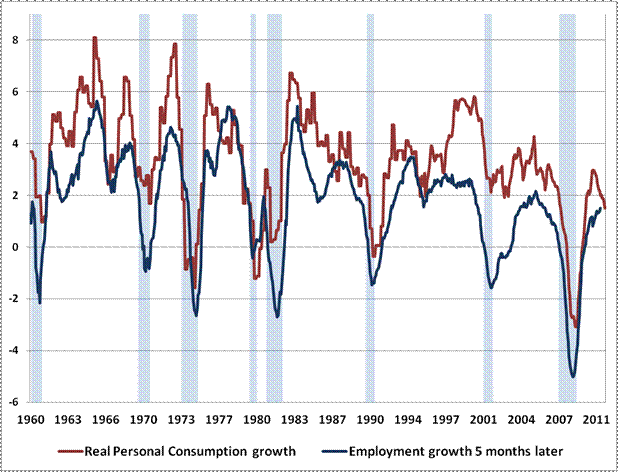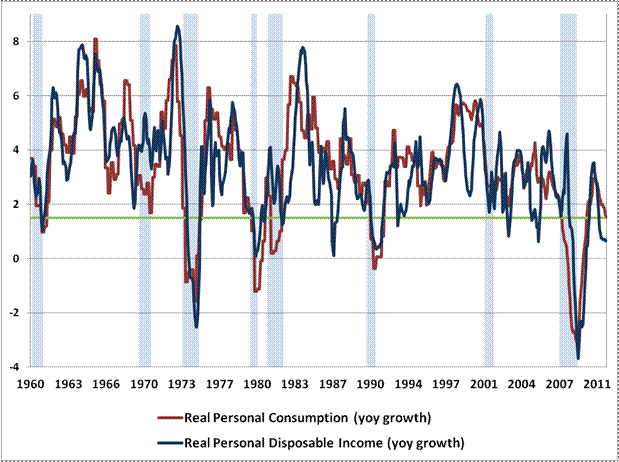The market cheered up the good NonFarm Payroll figures. But will it last ?
The criteria being:
• the Standard & Poor's 500 trading at more than 8% above its 52-week exponential moving average
• the S&P 500 up more than 50% from its four-year low
• the "Shiller P/E," based on the cyclically adjusted trailing 10-year earnings, developed by Yale economist Robert Shiller, greater than 18; it's currently 22
• the 10-year Treasury yield higher than six months earlier
• the Investors Intelligence's bullish advisory sentiment over 47%, and bearishness under 25%; in the latest data, the numbers were 47.9% bulls and 26.6% bears
We looked at the Hussman fund's weekly market comment and we found some interesting analysis which will point out to some less happy time in the second half and which to our
opinion is more relevant that the various above mentioned criteria.
A week ago, Lakshman Achuthan of the Economic Cycle Research Institute reiterated his own case for an oncoming recession saying "Consider it reaffirmed." Achuthan observed that given a broad aggregate of GDP growth, real sales, personal disposable income, industrial production, and other measures, we've never observed a similar decline in year-over-year growth without seeing a recession. Note that Achuthan does not simply consider the extent of the decline from a growth peak, but instead defines a downturn based on what he calls the "three P's" - pronounced, persistent, and pervasive. On this feature of the data, we are in agreement with ECRI - we've observed a uniformity of recession warnings in a broad set of leading data that we simply haven't observed across history except in association with recession.
At the same time, we've also seen an improvement in some measures - particularly new claims for unemployment - where the extent of positive progress we've seen is not at all typical of pre-recession periods. Similarly, while year-over-year employment growth remains quite tepid, that growth rate has been rising rather than falling (though we also saw that just before the 1981-1982 recession). While we know that payrolls and new claims for unemployment are actually lagging indicators, not leading ones, we still generally see new claims for unemployment creeping higher before recessions, unlike today.
So from our standpoint, the essential question is whether the improvement in job growth negates the evidence from leading indicators, and from coincident indicators that are now at year-over-year growth rates also associated with oncoming recessions. As uncomfortable as it is to contemplate a renewed economic downturn, the weight of the evidence still leans to the leading indicators and coincident growth rates. Achuthan made this point very precisely, noting that "downturns in job growth lag downturns in consumer spending growth, which is very clearly in a downturn. That's the sequence: jobs growth follows consumer spending growth, not the other way around."
To illustrate this, the following chart shows how growth in disposable income, personal consumption, and payroll employment correlates with recession. Leading up to a recession, and even until about 5 months after a recession starts, the evidence from personal consumption growth swamps the evidence from payroll employment growth. The growth rate of disposable income also provides better leading evidence of recession risk than payroll growth.

Notice that the peak in the correlation profile for personal consumption leads the peak in the profile for payroll employment by about 5 months. This is exactly what Achuthan is talking about. Consumption growth leads payroll growth, not the other way around. Indeed, in order to line up the peaks and troughs of the two, we have to shift payroll growth by a 5-month interval.

Now examine the year-over-year growth rate in personal income and personal consumption. With respect to personal income, we briefly observed slower year-over-year growth without recession in 1987, but recent months have shown a more persistent downturn. Similarly, real personal consumption growth (red) at 1.5% year-over-year growth is at levels that we have simply never observed historically except in connection with recessions.

Will things work out differently in the present case? Possibly, but it's a challenging argument. Consumption and income both disappointed expectations in the latest report last week, government spending is under pressure, last quarter featured a striking inventory buildup coupled with tepid final sales, we're seeing divergences between industrial stocks (production) and transport stocks (distribution) that smacks of oncoming inventory accumulation (which is the economic basis behind Dow Theory), and around the world, we're seeing a sudden dropoff in trade growth. Maybe despite the abominably weak menu of prospective returns available to investors, the Fed can engineer even further financial speculation and drive prospective returns even lower. Probably the best hope is that the recent improvement in job growth will be sustained - that it is a sign of a revival in production that will create its own demand - despite the indications from consumption growth, which suggest deteriorating job growth instead.
We've seen arguments that recession concerns can be discarded because GDP growth has increased over the past three quarters. But we often see this prior to recessions, just as we often see a burst of job growth in the months prior to a recession. That's exactly what keeps those periods in the "recovery" camp. Looking at the year before a recession starts, the general pattern is for GDP growth to stall to a fairly slow but positive growth rate 3 to 4 quarters ahead of the recession, followed by a strong but brief acceleration in GDP growth about 2 quarters before a recession begins, a modest positive quarter, and finally a drop to negative GDP growth. You rarely see a nice stair-step to lower and lower quarterly growth rates. The lowest quarterly GDP print in the year before a recession begins is usually about 3 quarters ahead. As a result of that stall, coupled with new quarters that are slower than the year earlier, we often see a slowdown in the overall year-over-year GDP growth rate as a recession approaches. On that note, the rate of GDP growth over the past three quarters is already lower than in the three quarters prior to 7 of the past 10 recessions, and the year-over-year growth rate is slower than it was just before 9 of them.
http://www.hussman.net/wmc/wmc120305.htm

Aucun commentaire:
Enregistrer un commentaire